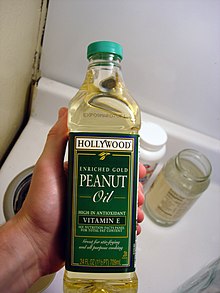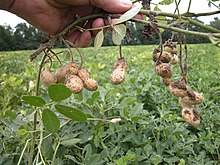peanut oil
| peanut oil | |
|---|---|

|
|
| Raw material plant (noun) |
Peanut ( Arachis hypogaea ) |
| origin |
Seeds |
| colour |
pale yellow, clear |
| ingredients | |
| Oleic acid | 35-69% |
| Linoleic acid | 13-35% |
| Palmitic acid | 8-14% |
| More fatty acids | Stearic acid 1.5-5%; Behenic acid 2-4%; Arachidic acid 1.5%; Lignoceric acid 1-2%; Gadoleic acid 0.5-1.5% |
| Σ saturated fat | 16.9% |
| Σ monounsaturated fatty acids | 46.2% |
| Σ polyunsaturated fatty acids | 32.0% |
| Other ingredients | Tocopherol 480 mg / kg |
| properties | |
| density | 0.911-0.925 kg / l at 15 ° C |
| viscosity | = 68-77 mPa · s at 20 ° C |
| Oxidation stability | 3-4 h |
| Melting point | −2 ° C |
| Smoke point | 160-207 ° C |
| Flash point | 290-315 ° C |
| Iodine number | 83-107 |
| Saponification number | 187-196 |
| Calorific value | 39.4 MJ / kg |
| Cetane number | 34.6 |
| Manufacturing and Consumption | |
| Production worldwide | approx. 6 million tons (2016) |
| Most important production countries | China , India , USA, Argentina , Indonesia , Myanmar , Nigeria , Sudan , Senegal |
Peanut oil is the vegetable oil pressed from the seeds of the peanut ( Arachis hypogaea ) .
Extraction
After the harvest, the peanuts have to be dried for around two to four weeks so that the water content is reduced from around 40% to only around 7 to 5%. The peanuts, which now have a fat content of around 45%, are then stripped of their shell. This is usually done with the help of disk mills or corrugated rollers. In order to extract the oil from the seeds, they have to be cleaned on sieves, crushed on roller mills and cold-pressed in screw presses . If you want to extract the residual oil that would otherwise remain in the press cake , it is extracted with n -hexane . The n- hexane is then distilled off from the extract, the residue remaining is peanut oil of an inferior quality compared to the oil obtained by cold pressing.
A fundamental distinction must be made between different qualities. The cold-pressed quality is considered to be the most natural and has the most intense taste. The majority of the amount of peanut oil on the market is processed through refining in order to obtain a defined, uniform quality. This also removes unwanted accompanying substances (e.g. aflatoxins ) and environmental contaminants (e.g. heavy metals, pesticides) that are undesirable during use and further processing.
In the European Pharmacopoeia (Ph. Eur.) Is refined peanut oil ( arachidis oleum raffinatum ) a monograph . The monograph specifies the quality / purity that must be maintained in order to be able to use the oil in pharmaceutical preparations. For example, the fatty acid composition of the triglycerides , the proportion of unsaponifiable material or that of free fatty acids are specified. Pharmacopoeia quality is also used in many other areas such as the cosmetics or food industry.
The European Pharmacopoeia also contains the monograph on hydrogenated peanut oil ( Arachidis oleum hydrogenatum ). This is peanut oil that has been partially hydrogenated. It is a white to slightly yellowish, soft mass that melts into a clear and pale yellow liquid when heated.
properties
A distinction is made between conventional peanut oil and African peanut oil . Peanut oil is slightly yellow in color, whereas refined peanut oil consists of a white, greasy-to-feel mass. African peanut oil forms a colorless to yellowish liquid.
Cold-pressed peanut oil has a light to clear "peanut note" and smells slightly fruity and rusty. Hardened, on the other hand, is almost odorless. Also African peanut oil has a peanut note. In terms of taste, African oil is rather mild and nutty. After the first cold pressing , peanut oil still has a very pleasant taste, but refined ones are almost tasteless. The smoke point of peanut oil is around 160 ° C, and that of refined oil is around 207 ° C. The melting point of peanut oil is between −2 ° C and +3 ° C, but it should also be noted that this oil becomes viscous at around 10 ° C.
The advantage of peanut oil is that it does not go rancid as quickly as many other oils. If it is sealed, dark and refrigerated, it will keep for one to two years. And even when stored unrefrigerated, it will last for several months.
Miscibility
The oil is miscible in all proportions with ether , petroleum ether , chloroform , benzene ; it is difficult to mix with absolute ethanol and immiscible with water .
composition
Peanut oil mainly consists of triglycerides , i.e. tri-esters of glycerine with various fatty acids . The fatty acids, the triglycerides present in peanut oil, are variable and depend on the growing area of the peanuts used for oil production. The European Pharmacopoeia specifies the following fatty acid composition for the purity of refined peanut oil: 35 to 72% (monounsaturated) oleic acid , 13 to 43% (diunsaturated) linoleic acid , 7 to 16% palmitic acid , 1.3 to 6.5% stearic acid , 0.5 to 3% arachidic acid , 1 to 5% behenic acid and 0.5 to 3% lignoceric acid . There are also tocopherols (several forms of vitamin E), other antioxidants , lecithin , hydrocarbons and sterols , especially β-sitosterol . The content of polyunsaturated fatty acid residues is relatively low.
use
Pharmacy and medicine
In the field of medicine and pharmacy , peanut oil is versatile. For example, it can be used as an enema to soften hard faeces in the rectum or lower the cholesterol level because of its content of unsaturated fatty acids in the triacylglycerides . In pharmaceutical technology, it is used as a carrier for fat-soluble active ingredients for external, enteral or parenteral use, especially for sex hormones with a depot effect and as an oil for eye drops. In dermatology , peanut oil is considered helpful against crusts and flakes of skin around the head. It can also be used for baby care and also as a bath additive for the treatment of subacute , chronic eczema as well as atopic eczema and ichthyosis . In addition, because of its good water absorption capacity, hydrogenated peanut oil serves as an ointment base. It used to be a common ingredient in old formulas such as camphor ointment (an ointment that is supposed to help with muscle, joint and rheumatic pain or colds and flu, as it stimulates blood circulation and relieves pain, and is also often found in nasal ointments or cold balms is). Today, however, this oil is used less and less in the manufacture of medicines, as it still goes rancid despite partial hydrogenation of the double bonds in the fatty acid portion of the tricylglycerides .
Cosmetics
In this area, peanut oil is often used as a massage oil, as it is only slowly absorbed into the skin and has good sliding properties. It is therefore a good base oil for massages. The peanut oil is also used as a bath oil or as a bath oil additive. In addition, this oil is also considered a good skin protection and is therefore used as a component of skin and sun oils. It can be used for baby and child care as well as skin and scalp care products. It also works very well against very dry or flaky skin and against eczema .
Industry
Peanut oil is often used in the food industry to make margarine or to refine soups and spices. It can also be used in the production of soaps or paints .
In addition, Rudolf Diesel had shown at the Paris World Exhibition in 1900 using an experimental internal combustion engine that peanut oil is suitable as a fuel.
kitchen
Due to its high flash point , the oil has good heat stability and is particularly used where high temperatures are required, such as for frying, grilling or deep-frying (especially in Chinese and Asian cuisine with a wok ).
The by-product that arises during oil extraction, the press cake , is often processed into protein-rich animal feed or soil fertilizers.
Web links
Individual evidence
- ↑ a b c d e peanut oil. Florapower GmbH & Co. KG, Augsburg, accessed on September 8, 2016 .
- ↑ a b c d e f g Ullmann's Food and Feed. Vol. 1, Wiley, 2017, ISBN 978-3-527-33990-7 , pp. 655, 664 f, 719.
- ↑ a b c d USDA National Nutrient Database for Standard Reference, SR19 ( Memento of the original from October 25, 2012 in the Internet Archive ) Info: The archive link was inserted automatically and has not yet been checked. Please check the original and archive link according to the instructions and then remove this notice.
- ↑ Bavarian State Ministry for State Development and Environmental Issues: Vegetable oil- powered combined heat and power plants. Part 1, 2002, p. 11 online (PDF; 2.12 MB), lfu.bayern.de, accessed on April 30, 2017.
- ↑ Alain Karle child: Manuel des corps gras. 2. Volumes, AFCEG, TEC DOC, Paris 1992, ISBN 978-2-85206-662-5 .
- ↑ Bertrand Matthäus: Which fat and oil for which purpose? Features and specifications of oils and fats. (PDF; 183 kB).
- ↑ BA Stout: Biomass Energy Profiles. Edition 54, FAO, 1983, ISBN 92-5-101302-0 , p. 86.
- ^ Forest Gregg: SVO. New Society, 2008, ISBN 978-0-86571-612-4 , p. 47.
- ↑ Oilseeds World Markets and Trade (PDF; 1.02 MB), USDA , May 2017, accessed on May 12, 2017.
- ^ Refining German Society for Fat Science eV, December 21, 2011.
- ↑ Monograph: Refined Erdnussöl , Ph.Eur., 6th edition, basic work 2008, p. 2450.
- ↑ Monograph: Hydrogenated Erdnussöl , Ph.Eur., 6th edition, Grundwerk 2008, p. 2449.
- ^ AB Awad, KC Chan, AC Downie, CS Fink: Peanuts as a source of beta-sitosterol, a sterol with anticancer properties. In: Nutr. Cancer. 36 (2), 2000, pp. 238-41, PMID 10890036 .
- ↑ Botanical Garden Mainz : Peanut .



